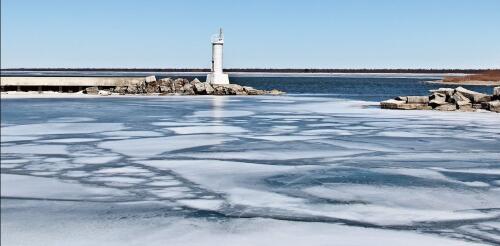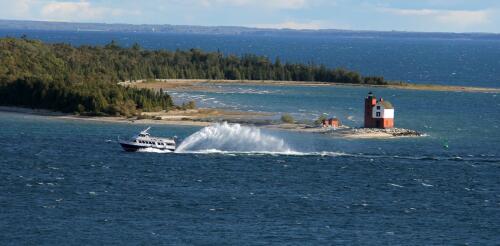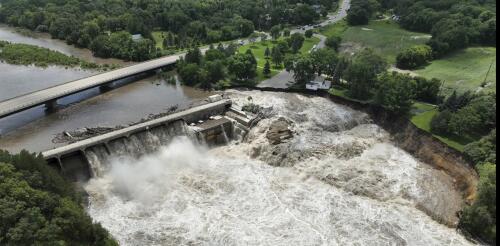Michigan
Winters on the Great Lakes are harsh – so much so that the scientists who work there often focus on the summer months, when tiny microbes at the base of the food chain were thought to be most productive. However, emerging research is changing our understanding of these winter ecosystems and shining a light on a vibrant world of winter activity just below the ice. Scientists discovered in the early 2000s that communities of diatoms – tiny photosynthesizing algae – were thriving in the light under the wind-swept lake ice. But, it turns out, that was only part of the story. As the Great Lakes’ winter ice disappears – it hit record lows in the winter of 2023-24 – new analyses show that some diatoms appear to have a different way to create energy and survive in the dark, turbid ice-free water until summer. A thin slice of Lake Erie ice collected by a scientist has diatom algae growing on the bottom....
The intersection of Fort Street and Oakwood Boulevard in southwest Detroit today functions mostly as a thoroughfare for trucks and commuters. However, as you sit idling at the stoplight waiting to cross the bridge over the Rouge River, you might glance to the side and see something unexpected in this heavily industrialized area: A sculpture of weathered steel reaches toward the sky alongside a spray of flowers and waves of grasses and people fishing. This inconspicuous corner, now the home of the Fort Street Bridge Park, has several stories to tell: of a river, a region, a historic conflict and an ongoing struggle. If you pull over, you’ll enter a place that attempts to pull together threads of history, environment and sustainable redevelopment. Signs explain why this sculpture and park are here: to honor the memory of protesters who met on this very spot on March 7, 1932, before marching up Miller Road to the massive Ford Rouge River Complex located in the adjacent c...
Should states and Indigenous nations be able to influence energy projects they view as harmful or contrary to their laws and values? This question lies at the center of a heated debate over Enbridge Energy’s Line 5 pipeline, which carries oil and natural gas across Wisconsin and Michigan. Courts, regulatory agencies and political leaders are deciding whether Enbridge should be allowed to keep its pipeline in place for another 99 years, with upgrades. The state of Michigan and the Bad River Tribe in Wisconsin want to close the pipeline down immediately. My expertise is in Great Lakes water and energy policy, environmental protection and sustainability leadership. I have analyzed and taught these issues as a sustainability scholar, and I have worked on them as the National Wildlife Federation’s Great Lakes regional executive director from 2015 until early 2023. In my view, the future of Line 5 has become a defining issue for the future of the Great Lakes region. It...
Heavy rainfall generated widespread flooding. in the Upper Midwest in late June 2024, putting at least one aging dam at risk. In southern Minnesota, the Blue Earth River cut a path around the Rapidan Dam in Rapidan Township, about 15 miles south of Mankato, on June 24, putting the structure at imminent risk of failing. Officials warned local residents that if the dam burst, the river could rise by 2 feet, but said that evacuations were not needed. This event comes a year after flooding in Vermont collapsed at least one dam and threatened others. Hiba Baroud, associate professor and associate chair in the department of civil and environmental engineering at Vanderbilt University, explains how flooding stresses dams in a changing climate. How serious is the risk when water flows over or around a dam? These conditions can result in erosion, which subsequently could lead to a dam breach or failure and a sudden, uncontrolled release of impounded water. The risk reflects the combin...



